Related Research Articles

Changi is a planning area located in the geographical region of Tanah Merah in the East Region of Singapore. Sharing borders with Pasir Ris and Tampines to the west, Changi Bay to the southeast, the South China Sea to the east and the Serangoon Harbour to the north. Changi, excluding the two water catchments and islands of Singapore, is the largest planning area by land size.

Pasir Ris is a planning area and residential town located in the East Region of Singapore. It is bordered by Tampines and Paya Lebar to the south, Sengkang to the southwest and Changi to the east. The planning area also shares riverine boundary with Punggol to the west, separated by the Serangoon River, as well as having a maritime boundary with the North-Eastern Islands planning area, across the Straits of Johor.
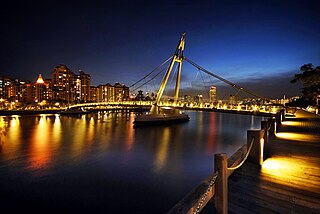
Kallang is a planning area and residential town located in the Central Region of Singapore.

Tampines is a planning area and residential town in the geographical region of Tanah Merah located along the north-eastern coast of the East Region of Singapore. The planning area is bordered by Bedok and Paya Lebar to the west, Pasir Ris to the north, Changi to the east, and the Singapore Straits to the south. Tampines New Town is located in the northern portion of Tampines planning area. Tampines is the third-largest new town in Singapore by area, covering over 2089 hectares of land, and also is the third most populated new town, following Bedok and Jurong West. It is the regional centre for the East Region.

Pasir Ris MRT station is an elevated Mass Rapid Transit (MRT) station on the East West line (EWL) in Pasir Ris, Singapore. Situated along Pasir Ris Central adjacent to Pasir Ris Bus Interchange and the White Sands Shopping Mall, it is the eastern terminus of the EWL and, as of June 2021, the only MRT station within Pasir Ris. The station exterior has the characteristic dome-shaped segmented roof also seen on other elevated EWL stations.

The Central Catchment Nature Reserve is the largest nature reserve in Singapore, occupying 2880 hectares. Forming a large green lung in the geographical centre of the city, it houses several recreational sites, including the Singapore Zoo, the Night Safari and the River Safari, as well as several newer facilities built to encourage public appreciation of the reserve, such as the HSBC TreeTop Walk. The reserve sits within the boundaries of the Central Water Catchment. It is one of the four gazetted nature reserves in Singapore. The other three are the Labrador Nature Reserve which was gazetted since 1 January 2002, Sungei Buloh Wetland Reserve and Bukit Timah Nature Reserve. All four nature reserves along with the parks are protected under the Parks & Trees Act 2005.
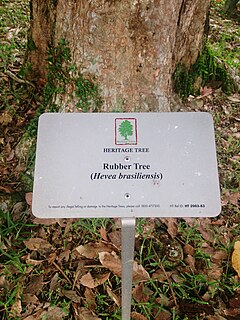
Heritage trees in Singapore are individual mature trees specially selected for protection by law under the Heritage Trees Scheme adopted on 17 August 2001. Implemented at the same time as the Heritage Roads scheme, it is part of a nationwide drive in tree conservation efforts not just within nature reserves, parks, and newly established tree conservation areas, but also anywhere else in the urban and rural environment of Singapore.
The following lists events that happened during 2002 in Singapore.

Pasir Ris Park is a beach park located in the eastern part of Singapore. It covers an area of 70 hectares, and was partially built on reclaimed land. Initially planned in the late 1970s to serve people living in the vicinity, the park was designed with the help of two Japanese landscape specialists. Construction began on the park in September 1984, and the park was opened in phases from August 1986 to 1991. The park was further expanded in 2007, with the addition of new areas such as a herb garden.

Changi Beach Park is a beach park located at the northern tip of Changi in the eastern region of Singapore.
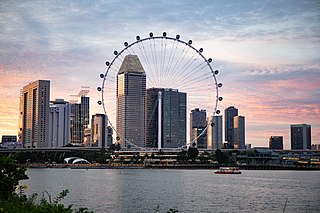
This article shows the notable future developments in Singapore. Majority of them are currently under construction with most to be completed within the next five years.
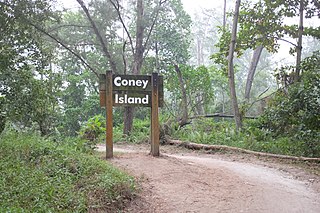
Coney Island, alternatively known as Pulau Serangoon, is a 133-hectare island located off the northeastern coast of Singapore within the town of Punggol, between Pulau Ubin to its northeast and the mainland to its southwest.

Kent Ridge Park is a 47-hectare public park located in Kent Ridge, Singapore, between the National University of Singapore and the Singapore Science Park. Due to its undisturbed habitat and abundant plant life, it is a popular venue for bird-watchers and eco-tourists.
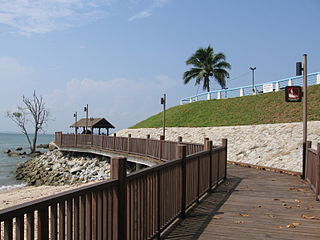
The Changi Boardwalk, also known as Changi Point Coastal Walk (樟宜尾沿岸木板路), is a 2.2 km boardwalk at Changi Point, Singapore.
The Changi Tree, also known as The Time Tree, was a tree in Singapore that was noted for its height of 76 meters. The species of the tree is unclear, but it was either Hopea sangal or Sindora wallichii. It has been said that Changi was named after this tree. It has been recorded that Changi was named after Neobalanocarpus heimii by the legendary botanist H.N. Ridley. However, there has been no evidence that the tree had ever been in Changi.
West Coast Park is a park located at the south-westernmost corner of Queenstown in Singapore. It runs parallel to West Coast Highway. The park covers an area of roughly 50 hectares.

The Cross Island Line is a high capacity Mass Rapid Transit (MRT) line under development in Singapore. It's one of the two future lines for the Mass Rapid Transit. The eighth MRT line, the CRL will run in the general east–west direction from Changi to Jurong Industrial Estate via Loyang, Pasir Ris, Hougang, Ang Mo Kio, Sin Ming, Bukit Timah, Clementi and the West Coast. From Pasir Ris, the line will branch off to Punggol. Coloured lime on official maps, the CRL will be at least 50 kilometres (31 mi) long, serving 30 over stations. It will be the sixth MRT line to be completely automated and driverless, as well as the fourth high capacity MRT line.
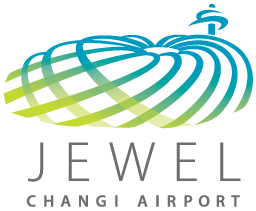
Jewel Changi Airport is a nature-themed entertainment and retail complex on the inside of Changi Airport, Singapore, linked to three of its passenger terminals. Its centrepiece is the world's tallest indoor waterfall, the Rain Vortex, which is surrounded by a terraced forest setting.
References
- ↑ "Tree Conservation Areas". National Parks Board. Retrieved 12 October 2021.
- ↑ "Felling of the Chengal Pasir tree | Infopedia". eresources.nlb.gov.sg. Retrieved 12 October 2021.
- ↑ "The Hopea sangal Time Line". habitatnews.nus.edu.sg. Retrieved 12 October 2021.